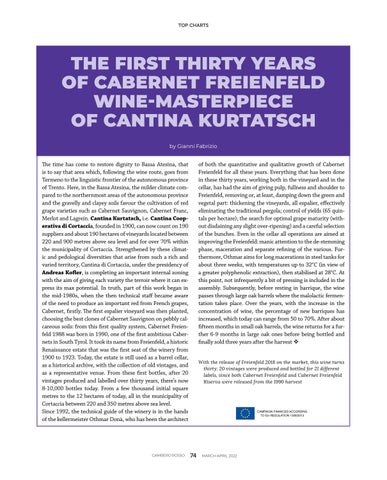TOP CHARTS
THE FIRST THIRTY YEARS OF CABERNET FREIENFELD WINE-MASTERPIECE OF CANTINA KURTATSCH by Gianni Fabrizio
of both the quantitative and qualitative growth of Cabernet Freienfeld for all these years. Everything that has been done in these thirty years, working both in the vineyard and in the cellar, has had the aim of giving pulp, fullness and shoulder to Freienfeld, removing or, at least, damping down the green and vegetal part: thickening the vineyards, all espalier, effectively eliminating the traditional pergola; control of yields (65 quintals per hectare); the search for optimal grape maturity (without disdaining any slight over-ripening) and a careful selection of the bunches. Even in the cellar all operations are aimed at improving the Freienfeld: manic attention to the de-stemming phase, maceration and separate refining of the various. Furthermore, Othmar aims for long macerations in steel tanks for about three weeks, with temperatures up to 32°C (in view of a greater polyphenolic extraction), then stabilised at 28°C. At this point, not infrequently a bit of pressing is included in the assembly. Subsequently, before resting in barrique, the wine passes through large oak barrels where the malolactic fermentation takes place. Over the years, with the increase in the concentration of wine, the percentage of new barriques has increased, which today can range from 50 to 70%. After about fifteen months in small oak barrels, the wine returns for a further 6-9 months in large oak ones before being bottled and finally sold three years after the harvest
The time has come to restore dignity to Bassa Atesina, that is to say that area which, following the wine route, goes from Termeno to the linguistic frontier of the autonomous province of Trento. Here, in the Bassa Atesina, the milder climate compared to the northernmost areas of the autonomous province and the gravelly and clayey soils favour the cultivation of red grape varieties such as Cabernet Sauvignon, Cabernet Franc, Merlot and Lagrein. Cantina Kurtatsch, i.e. Cantina Cooperativa di Cortaccia, founded in 1900, can now count on 190 suppliers and about 190 hectares of vineyards located between 220 and 900 metres above sea level and for over 70% within the municipality of Cortaccia. Strengthened by these climatic and pedological diversities that arise from such a rich and varied territory, Cantina di Cortaccia, under the presidency of Andreas Kofler, is completing an important internal zoning with the aim of giving each variety the terroir where it can express its max potential. In truth, part of this work began in the mid-1980s, when the then technical staff became aware of the need to produce an important red from French grapes, Cabernet, firstly. The first espalier vineyard was then planted, choosing the best clones of Cabernet Sauvignon on pebbly calcareous soils: from this first quality system, Cabernet Freienfeld 1988 was born in 1990, one of the first ambitious Cabernets in South Tyrol. It took its name from Freienfeld, a historic Renaissance estate that was the first seat of the winery from 1900 to 1923. Today, the estate is still used as a barrel cellar, as a historical archive, with the collection of old vintages, and as a representative venue. From these first bottles, after 20 vintages produced and labelled over thirty years, there’s now 8-10,000 bottles today. From a few thousand initial square metres to the 12 hectares of today, all in the municipality of Cortaccia between 220 and 350 metres above sea level. Since 1992, the technical guide of the winery is in the hands of the kellermeister Othmar Donà, who has been the architect
GAMBERO ROSSO
With the release of Freienfeld 2018 on the market, this wine turns thirty: 20 vintages were produced and bottled for 21 different labels, since both Cabernet Freienfeld and Cabernet Freienfeld Riserva were released from the 1990 harvest
74
MARCH-APRIL 2022
